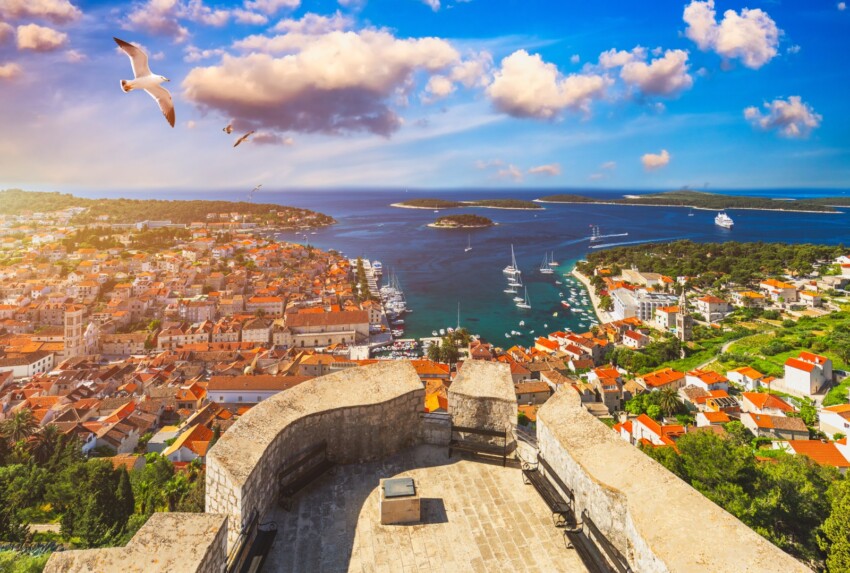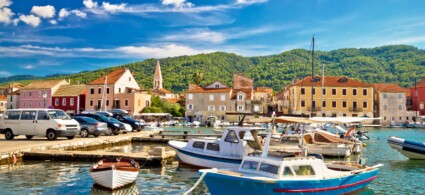

Do you love the sun and are looking for a destination where a rainy day is almost impossible? Book your hotel now on Hvar, the Croatian island with the most days of sunshine.
This enviable record, estimated at 2724 hours of sunshine per year, is not the only reason why the island is famous: Hvar is considered the most exclusive of Croatian islands. Hvar Town ‘s expensive hotels, chic restaurants and nightlife venues make it a perfect destination for those who like to be in the limelight.
Those who want to escape the crowds, or simply spend less, can opt for another of the island’s pretty resorts. Leaving behind the elegant old town of Hvar, this ‘Madeira of Croatia‘ is in fact a little natural paradise waiting to be explored, with fields of lavender and expanses of aromatic plants, mountains alternating with green landscapes, old villages and coves with crystal-clear sea.
The panorama is dominated by the mountain range that rises in the centre of the island, while a fertile plain stretches out in the south.
Exploring the hinterland, you will be inebriated by the colours and scents of the island’s vegetation, which includes areas of Mediterranean maquis, but also olive, fig, grape and lavender trees.
For a dip in the sea, you can choose one of the numerous beaches dotting Hvar’s rugged coastline.

Hvar is an elegant medieval town enclosed within 14th-century walls, surrounded by pine forests and overlooking a blue sea.
Over time, it has built a reputation as a ‘glamorous town’, where you can find luxurious hotels, elegant restaurants and a long trail of beach bars for young nightlife seekers.
Despite its higher prices than other Croatian resorts, it is estimated that at peak season at least 20,000 tourists a day flock to its traffic-free cobbled streets, its main square, the long seaside promenade and the many rocky beaches in the surrounding area.
Sights in the town

Less charming but older and more relaxed than Hvar, Stari Grad lies on a horseshoe-shaped bay on the island’s northern coast.
It can be a good alternative to Hvar town, which is very crowded in the summer months. The two most interesting sights to visit are the Dominican Monastery founded in 1482 and Tvrdalj, the castle that Croatian writer Petar Hektorovics had built in the 16th century.
Inside the castle, numerous details testify to the writer’s love of fish and fishermen, to whom he also dedicated his most famous work, ‘A Conversation on Fishing and Fishermen’.

The small town of Jelsa is another good option for those wishing to stay on the island of Hvar. Surrounded by pine forests and poplar groves where you can seek shelter from the sun on hot days, it has a lovely old town and numerous small beaches and coves in the surrounding area.
There’s another good reason to choose Jelsa: accommodation here is a little cheaper than on Hvar or Stari Grad.

Probably the most famous beach on the island, with its crystal clear sea and romantic atmosphere Dubovica is a little gem.
Located in the southern part of the island in a small bay sheltered from the wind, it is a pebble beach overlooked by a pretty little stone house.
This pebble beach set in a bay surrounded by a pine forest is the place for those who do not like crowded beaches.
It seems that Lucisca beach has the power to help couples who want to have children, but don’t use the caves around the bay to find out if this is true: leave it to those who want to explore the magnificent surroundings of the beach on foot.
Mina and Mlaska are two sandy beaches, and therefore suitable for families with children. The former is located 500 metres from the centre of Jelsa, while the latter is 4 km from the village of Sućuraj.
The uninhabited islet of Jerolim, still little known to tourists, is an unmissable destination for naturists, who can find here one of the most beautiful naturist beaches in the world.
For more than 40 years, naturists have been coming to spend hours relaxing on Kordovan beach, attracted by its breathtaking beauty and the unique energy that can be felt in this extraordinary place.
The bay is surrounded by wild nature and is a true oasis of relaxation, light years away from the stress of modern life.
If you want to add something extra to your beach holiday, here are some suggestions for activities to do on the island of Hvar:

If you are already in mainland Croatia you can take a ferry to Hvar from Rijeka, Split and Dubrovnik. Some are only passenger ships, while others are full-fledged car ferries.
From the port of Starigrad, local buses depart for all the towns on the island.
There are plenty of options for sleeping on Hvar. Scattered around the island are numerous private rooms and flats, which locals rent out during the summer months. In addition, which is rare in Croatia, there are also a number of high standard hotels.
Choosing where to stay on Hvar depends largely on the type of holiday you intend to take. Those looking for glamour and nightlife should head straight for Hvar Town, located at the western end of the island, perhaps choosing one of the prestigious hotels overlooking the harbour.
Stari Grad, which lies in a cove on the north coast, is ideal for families, as first of all it is the first town you come to as soon as you get off the ferry, which greatly reduces ferry-accommodation travel time, and secondly you can find cheaper solutions while still having a range of essential services such as supermarkets, shops and pharmacies.
Those arriving on Hvar from Croatia who don’t have much time can stay in the vicinity of Sućuraj, the easternmost town on the island, and limit themselves to a visit to the eastern part of the island, while those who enjoy beach life can choose accommodation along the north coast, which is crossed by the winding D116 road. Here you will find, among others, the beaches of Prapatna, Mlaska and Skamp, on the edge of which you can stay in a number of flats and rooms for rent.
Theisland of Hvar, one of the most exclusive and glamorous holiday spots in the entire Adriatic, lies just off the coast of Dalmatia, a region in southern Croatia. It is roughly halfway between Split and Dubrovnik, surrounded by three other islands: Brac, Vis and Korcula. It is situated at the same latitude as Pescara, from which it is less than 200 kilometres away as the crow flies.




